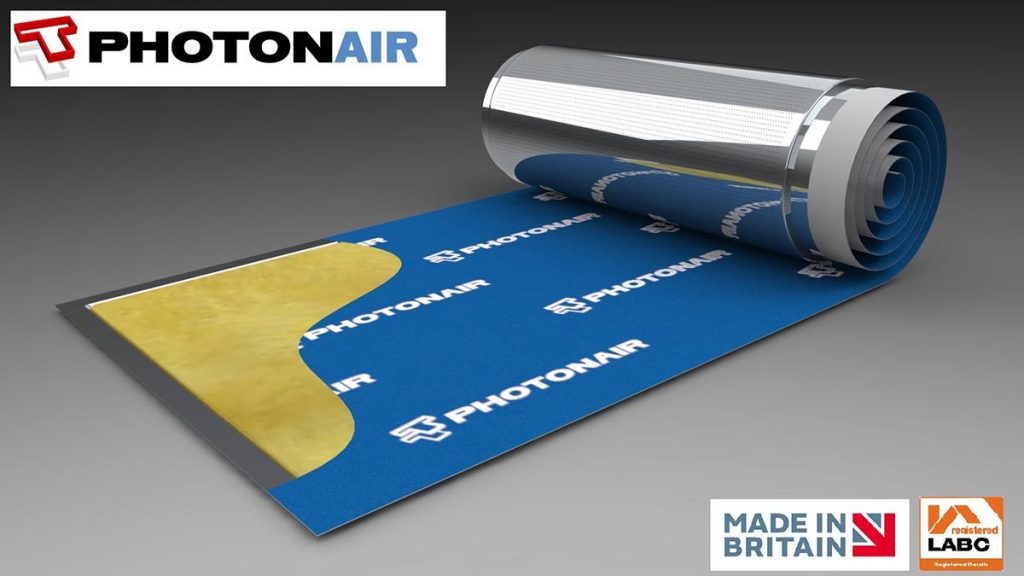Mark Seddon, a director at Thermic Technology outlines why thermal performance should be a clear consideration when thinking of insulation…
Weighing up the pros and cons between achieving better thermal performance and risking condensation is a fundamental requirement for many of today’s new build and refurbishment roofing projects. Yet by cutting through the technical jargon, it’s not such a complex decision to make. Here Mark Seddon, of Thermic Technology talks about the importance of considering low resistance underlays in your insulation choices.
Synthetic breather membranes first emerged in northern Europe more than 15 years ago and following research by the BRE (Building Research Establishment) and BSi (British Standards Institution) it was established that a requirement of vapour resistance of below 0.25 MN.s/g would classify a true breather membrane for use in warm roof and cold non-vented applications. It was also agreed that a higher vapour resistance than this carries a risk of interstitial condensation forming.
It’s important to understand the definition of condensation and in particular interstitial condensation. While most would understand that condensation is the process of water vapour in the air condensing from a gas into a liquid, interstitial condensation is different. Interstitial condensation is a form of structural damping that occurs when warm, moist air penetrates inside a wall, roof or floor structure, reaches the dew point and condenses into liquid water.
Interstitial condensation can cause deterioration of the building fabric, through corrosion, rot and decay. It can also reduce the thermal resistance of materials thus adversely affecting energy efficiency.
For the new generation of insulating breather membranes thermal resistance is important but vapour resistance is even more critical and the magic 0.25 MN.s/g should not be overlooked.
When assessing such risks within a warm pitched roof, designers should take the following inter-related factors into account:
- the airtightness of the ceiling, which determines how much heat, air and water vapour are transferred by convection;
- the vapour resistance of the ceiling, which determines how much water vapour will be transferred across the ceiling;
- the vapour resistance (Low Resistance or High Resistance) of any underlay;
- the air permeability of the external covering of the roof, which determines the rate at which water vapour can disperse by diffusion and convection;
- use of an AVCL which will determine how much water vapour will be transferred to the roof both by diffusion; and convection;
- the degree and location of the thermal insulation within the structure.
Looking at vapour resistance, according to BS 5250:2011 (Code of Practice for Control of Condensation in Buildings) there are two types of roofing underlay:
- HR (High Resistance) having a water vapour resistance greater than 0.25 MN.s/g
- LR (Low Resistance) having a water vapour resistance not exceeding 0.25 MN.s/g
With High Resistance underlays, BS 5250:2011 is clear that: “In roofs with an HR underlay.., whatever form of external covering or ceiling is provided, there is a risk of interstitial condensation forming on the underside of the HR underlay”.
Here BS 5250:2011 recommends that to avoid that risk, an Air and Vapour Control Layer should be provided on the warm side of the insulation, and ventilated voids formed between the underside of the underlay and the insulation. Each void should be at least 25 mm deep and be vented at both high and low level.
The requirement to ventilate below a high resistance (HR) insulating underlay, however dramatically reduces any thermal benefit it gives to the roof structure – and so the balancing act begins . . . or does it need to?
PhotonAir is a Low Resistance (LR) insulating underlay approved by LABC; it upgrades thermal performance without the risk of condensation. Made with high density glasswool encapsulated between a perforated reflective lower layer and Klober Permo® air, the product is installed in the same way as a standard roofing tile underlay.
In warm pitched roofs, PhotonAir removes the risk of interstitial condensation forming and in doing so there is then no requirement to ventilate the underside of the underlay and there may not be the requirement to provide an AVCL on the warm side if it is not practicable to do so.
Low Resistance underlays are the only type of underlay that removes the risk of interstitial condensation forming without the need for any associated ventilation to roof voids. Turning a complex ventilation job into something much more manageable.
Further information about the Code of Practice for Control of Condensation in Buildings can be found at http://shop.bsigroup.com/
Mark Seddon is a director with Thermic Technology, a British-based company which specialises in the design and manufacture of thin reflective insulation for the professional and self-build markets.
Mark has been at the forefront of the multifoil insulation industry since 2007 and understands how to create cost effective, thermally enhanced insulation products. Mark can be contacted via LinkedIn: https://www.linkedin.com/pub/mark-seddon/18/b98/4b3 or by email: mark.seddon@thermictechnology.co.uk
Further information about the Photon range and Thermic Technology visit www.thermictechnology.co.uk

Mark Seddon
Sales Director
Thermic Technology
01257 241084 / 07703546063
http://thermictechnology.co.uk/
Please note: this is a commercial profile




